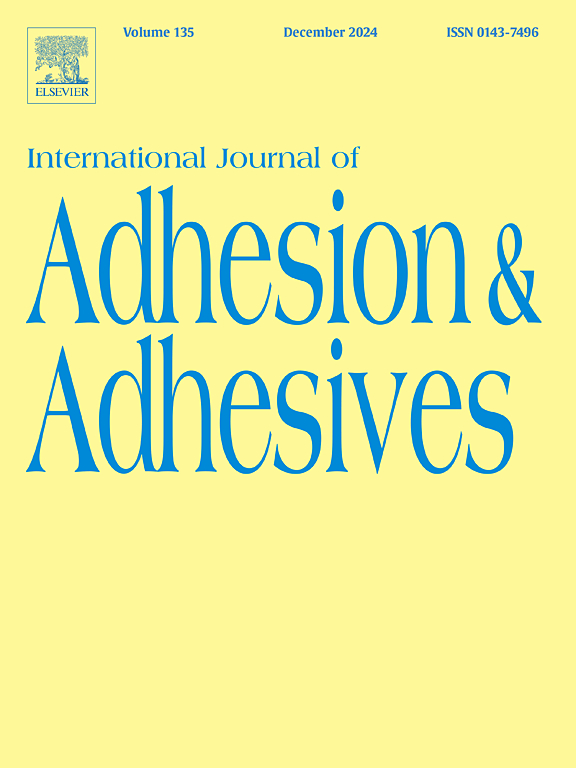Bond strength to aged CAD/CAM composites and polymer-infiltrated ceramic network using a universal adhesive with or without previous application of a universal primer
IF 3.2
3区 材料科学
Q2 ENGINEERING, CHEMICAL
International Journal of Adhesion and Adhesives
Pub Date : 2025-03-24
DOI:10.1016/j.ijadhadh.2025.104017
引用次数: 0
Abstract
Objective
To analyse the bond strength to aged CAD/CAM composites and a polymer-infiltrated ceramic network (PICN) after different surface pretreatments and the use of a universal adhesive or universal primer and universal adhesive.
Methods
Specimens were prepared from CAD/CAM composites (Brilliant Crios, Grandio Blocs, Lava Ultimate, Tetric CAD, Cerasmart270, Katana Avencia, Shofu Block HC) or PICN (Vita Enamic) and artificially aged (5000 cycles, 5–55 °C). The surfaces were left untreated or pretreated by mechanical roughening, aluminium oxide sandblasting, silica coating, or hydrofluoric acid etching (PICN only). The surfaces were further conditioned with a universal adhesive only or a universal primer/universal adhesive (each subgroup n = 12). After application of a composite and further thermal cycling, shear bond strength and failure modes were assessed and statistically analysed by ANOVAs, Weibull statistics, and Chi2-test (p < 0.05).
Results
In CAD/CAM composites, highest bond strength values were obtained for sandblasting (mean of all subgroups: 15.7 ± 4.5 MPa) > silica coating (13.5 ± 4.1 MPa) > mechanical roughening (11.3 ± 4.5 MPa) > no pretreatment (4.1 ± 2.3 MPa). The use of a universal primer led to a significant, albeit small increase of bond strength (11.9 ± 6.0 > 10.4 ± 5.6 MPa). In PICN bond strength was: hydrofluoric acid etching (15.2 ± 4.0 MPa) > silica coating (12.2 ± 4.3 MPa) > sandblasting (11.6 ± 5.3 MPa) > mechanical roughening (10.9 ± 7.2 MPa) > no pretreatment (2.8 ± 2.7 MPa). The application of a universal primer led to a significant increase of bond strength (13.5 ± 6.3 > 7.6 ± 5.0 MPa).
Significance
Adhesion to aged CAD/CAM composites mainly requires adequate micromechanical retention, while PICN additionally requires the use of a universal primer.
与老化的CAD/CAM复合材料和聚合物渗透陶瓷网络的结合强度,使用通用粘合剂,无论是否事先应用通用底漆
目的分析不同表面预处理及通用胶粘剂或通用底漆和通用胶粘剂对老化CAD/CAM复合材料与聚合物渗透陶瓷网(PICN)的粘结强度。方法采用CAD/CAM复合材料(Brilliant Crios, Grandio blocks, Lava Ultimate, Tetric CAD, Cerasmart270, Katana Avencia, Shofu Block HC)或PICN (Vita Enamic)制备标本,并人工老化(5000循环,5-55°C)。表面未经处理或通过机械粗化、氧化铝喷砂、二氧化硅涂层或氢氟酸蚀刻(仅限PICN)进行预处理。表面进一步用通用粘合剂或通用底漆/通用粘合剂进行处理(每个亚组n = 12)。应用复合材料并进一步热循环后,通过方差分析、威布尔统计和chi2检验对剪切粘结强度和破坏模式进行评估和统计分析(p <;0.05)。结果在CAD/CAM复合材料中,喷砂组粘结强度最高(各亚组平均值:15.7±4.5 MPa);二氧化硅涂层(13.5±4.1 MPa) >;机械粗化(11.3±4.5 MPa);无预处理(4.1±2.3 MPa)。使用通用底漆可以显著提高粘结强度(11.9±6.0 >;10.4±5.6 MPa)。PICN中的结合强度为:氢氟酸蚀刻(15.2±4.0 MPa) >;硅涂层(12.2±4.3 MPa) >;喷砂(11.6±5.3 MPa) >;机械粗化(10.9±7.2 MPa) >;无预处理(2.8±2.7 MPa)。通用底漆的应用使粘接强度显著提高(13.5±6.3 >;7.6±5.0 MPa)。对老化CAD/CAM复合材料的粘附主要需要足够的微机械保持性,而PICN还需要使用通用底漆。
本文章由计算机程序翻译,如有差异,请以英文原文为准。
求助全文
约1分钟内获得全文
求助全文
来源期刊

International Journal of Adhesion and Adhesives
工程技术-材料科学:综合
CiteScore
6.90
自引率
8.80%
发文量
200
审稿时长
8.3 months
期刊介绍:
The International Journal of Adhesion and Adhesives draws together the many aspects of the science and technology of adhesive materials, from fundamental research and development work to industrial applications. Subject areas covered include: interfacial interactions, surface chemistry, methods of testing, accumulation of test data on physical and mechanical properties, environmental effects, new adhesive materials, sealants, design of bonded joints, and manufacturing technology.
 求助内容:
求助内容: 应助结果提醒方式:
应助结果提醒方式:


